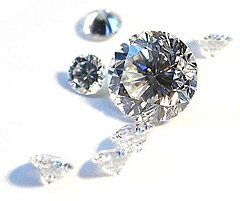Díámọ̀ndì
| Àyọkà yìí únfẹ́ ìyílédèdà sí Yorùbá. Ẹ ran Wikipedia lọ́wọ́ ṣàtúnṣe sí ìyílédèdà |
In mineralogy, díámọ̀ndì (from the ancient Greek αδάμας – adámas "unbreakable") is an allotrope of carbon, where the carbon atoms are arranged in a variation of the face-centered cubic crystal structure called a diamond lattice. Diamond is less stable than graphite, but the conversion rate from diamond to graphite is negligible at ambient conditions. Diamond is renowned as a material with superlative physical qualities, most of which originate from the strong covalent bonding between its atoms. In particular, diamond has the highest hardness and thermal conductivity of any bulk material. Those properties determine the major industrial application of diamond in cutting and polishing tools and the scientific applications in diamond knives and diamond anvil cells.
| Diamond | |
|---|---|
 A scattering of round-brilliant cut diamonds shows off the many reflecting facets. | |
| General | |
| Category | Native Minerals |
| Chemical formula | C |
| Identification | |
| Molar mass | 12.01 g·mol-1 |
| Color | Typically yellow, brown or gray to colorless. Less often blue, green, black, translucent white, pink, violet, orange, purple and red. |
| Crystal habit | Octahedral |
| Crystal system | Isometric-Hexoctahedral (Cubic) |
| Cleavage | 111 (perfect in four directions) |
| Fracture | Conchoidal (shell-like) |
| Mohs scale hardness | 10 |
| Luster | Adamantine |
| Streak | colorless |
| Diaphaneity | Transparent to subtransparent to translucent |
| Specific gravity | 3.52±0.01 |
| Density | 3.5–3.53 g/cm3 |
| Polish luster | Adamantine |
| Optical properties | Singly Refractive |
| Refractive index | 2.418 (at 500 nm) |
| Birefringence | None |
| Pleochroism | None |
| Dispersion | 0.044 |
| References | [1][2] |

|
Àyọkà yìí tàbí apá rẹ̀ únfẹ́ àtúnṣe sí. Ẹ le fẹ̀ jù báyìí lọ tàbí kí ẹ ṣàtúnṣe rẹ̀ lọ́nà tí yíò mu kúnrẹ́rẹ́. Ẹ ran Wikipedia lọ́wọ́ láti fẹ̀ẹ́ jù báyìí lọ. |
Itokasi
àtúnṣe